TAXATION Assignment - Analysis of Tax Regulations and GST Implications
VerifiedAdded on 2020/04/01
|10
|1282
|37
Homework Assignment
AI Summary
This TAXATION assignment solution analyzes various aspects of Australian taxation law. It begins by explaining taxable earnings, deductible expenses, and relevant sections of the Income Tax Assessment Act 1997, including allowable deductions for business-related expenses. The assignment then delves into the Goods and Services Tax (GST), specifically addressing the input tax credit for businesses and analyzing a case study involving a bank's advertisement expenses. The solution determines the eligibility of input tax credits based on the nature of the expenses. Furthermore, the assignment covers the offsetting of foreign tax, providing calculations and examples to illustrate the process. The document includes tables summarizing key financial figures and references relevant taxation regulations and scholarly articles.
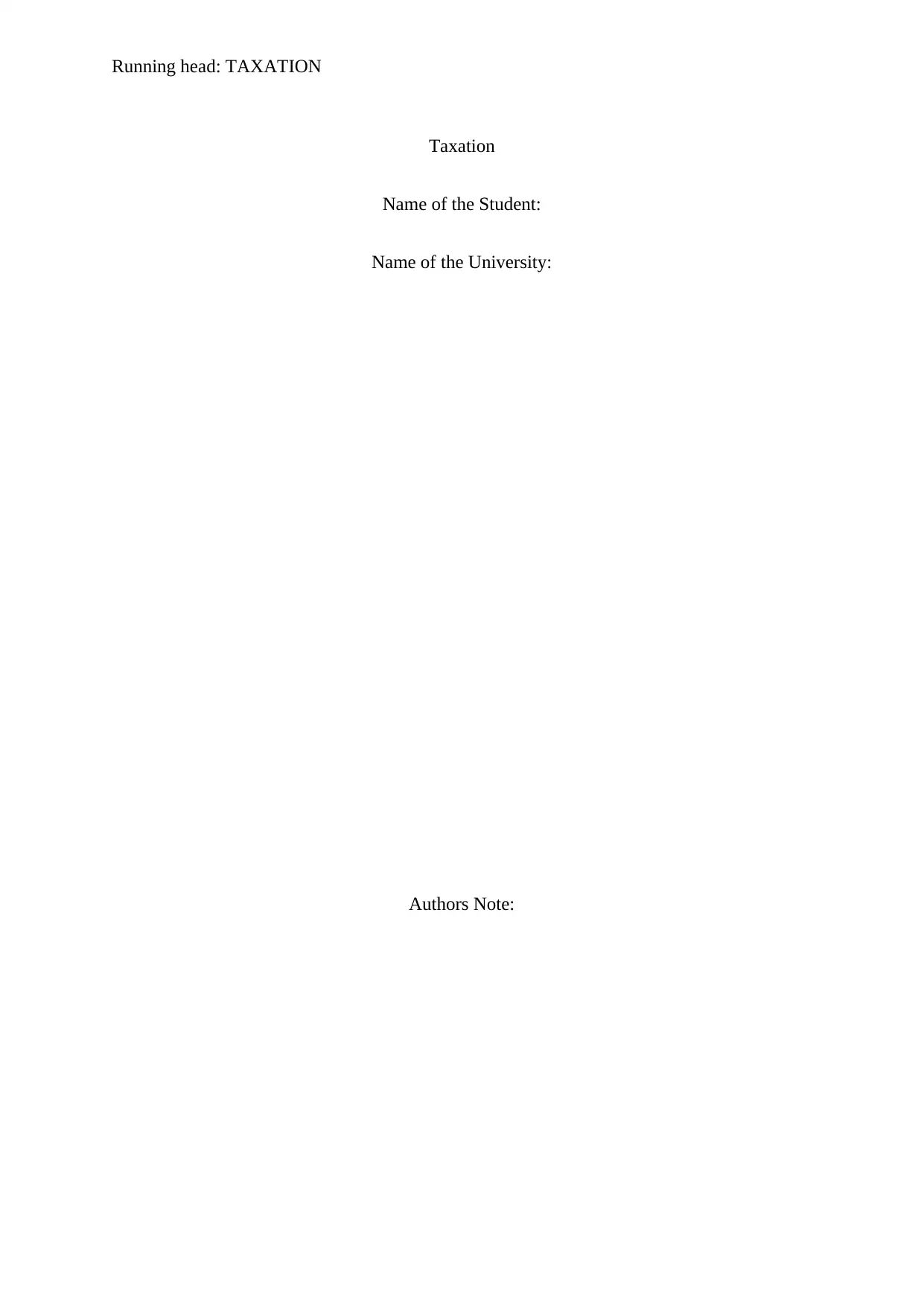
Running head: TAXATION
Taxation
Name of the Student:
Name of the University:
Authors Note:
Taxation
Name of the Student:
Name of the University:
Authors Note:
Paraphrase This Document
Need a fresh take? Get an instant paraphrase of this document with our AI Paraphraser
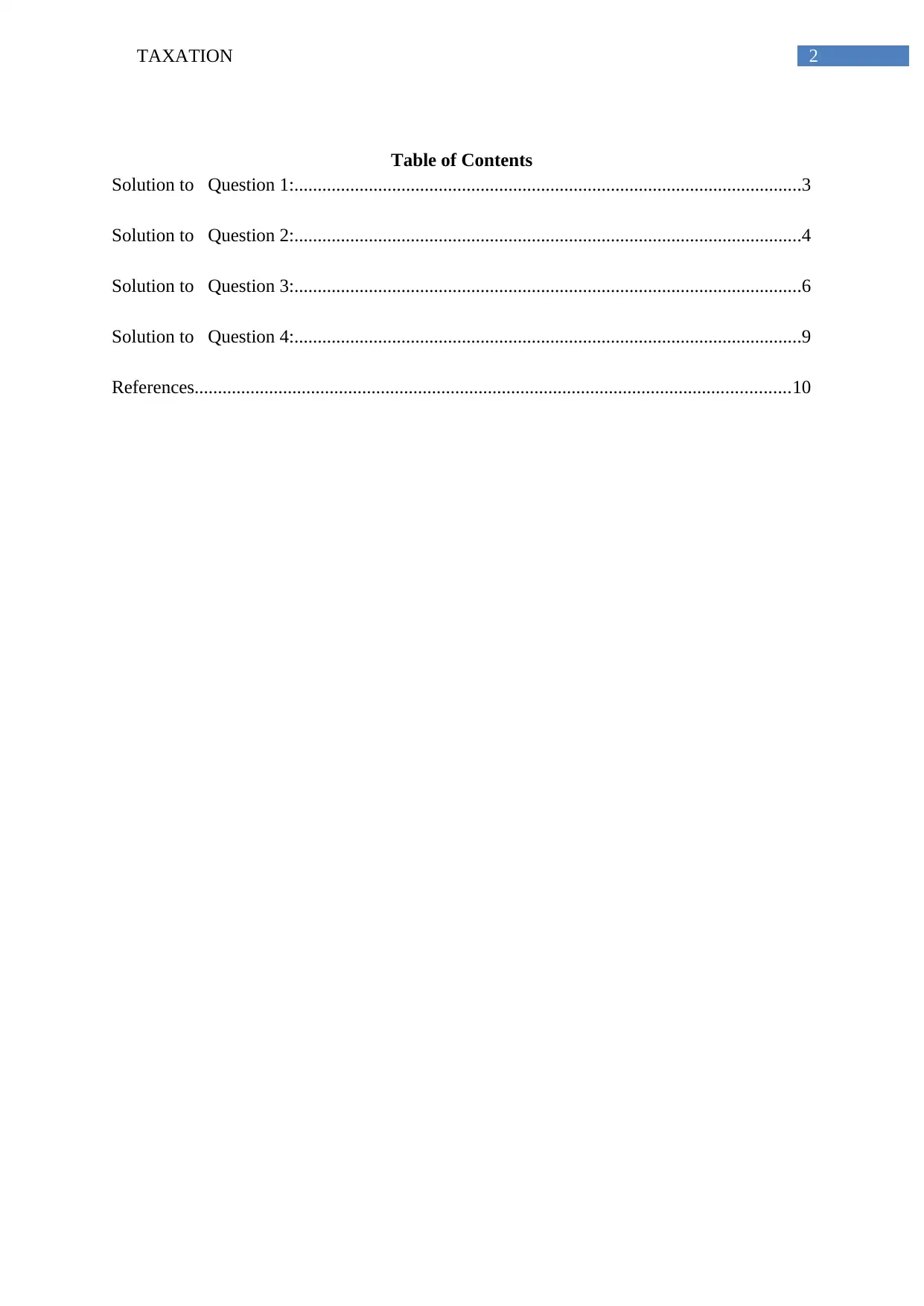
2TAXATION
Table of Contents
Solution to Question 1:.............................................................................................................3
Solution to Question 2:.............................................................................................................4
Solution to Question 3:.............................................................................................................6
Solution to Question 4:.............................................................................................................9
References................................................................................................................................10
Table of Contents
Solution to Question 1:.............................................................................................................3
Solution to Question 2:.............................................................................................................4
Solution to Question 3:.............................................................................................................6
Solution to Question 4:.............................................................................................................9
References................................................................................................................................10
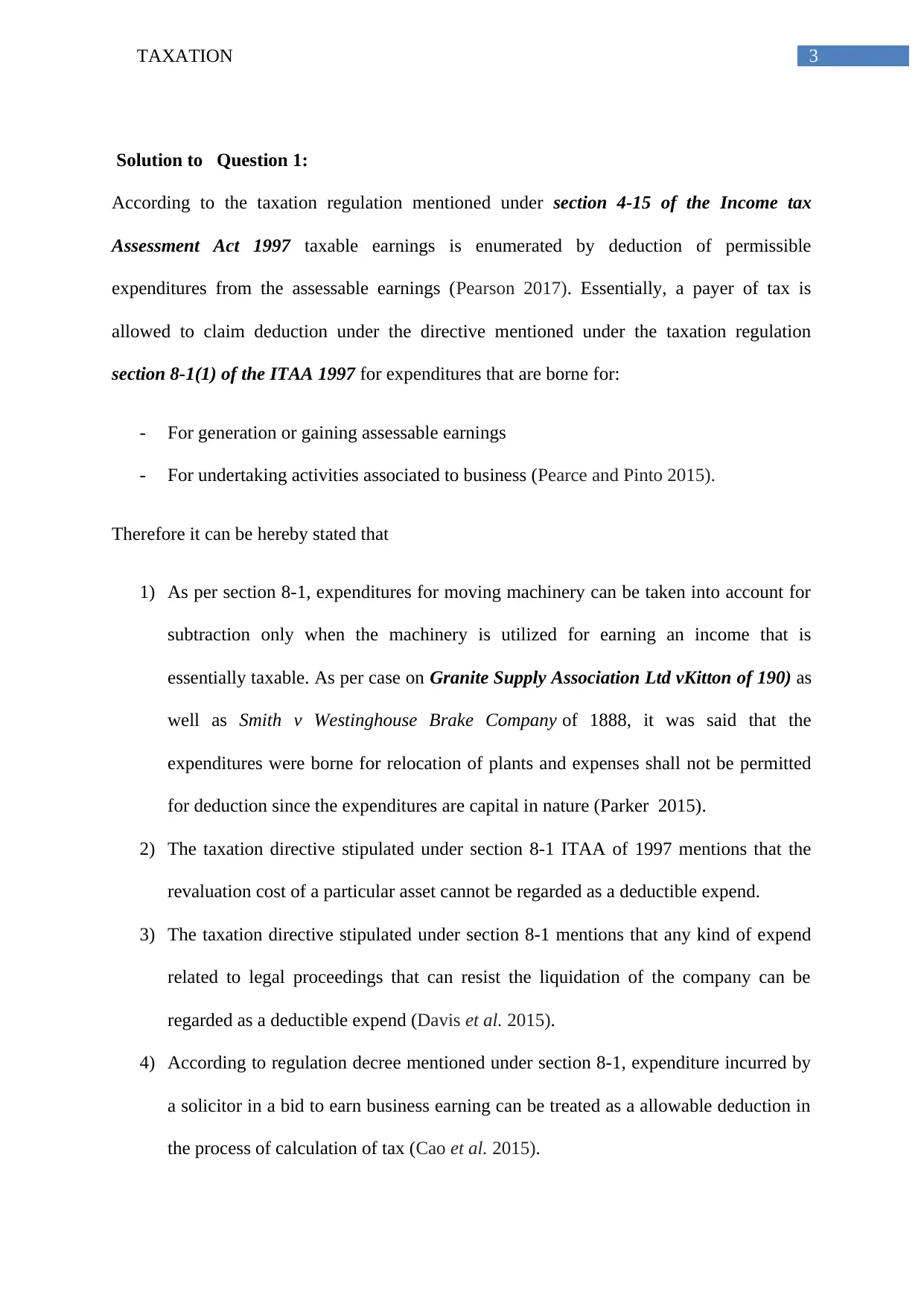
3TAXATION
Solution to Question 1:
According to the taxation regulation mentioned under section 4-15 of the Income tax
Assessment Act 1997 taxable earnings is enumerated by deduction of permissible
expenditures from the assessable earnings (Pearson 2017). Essentially, a payer of tax is
allowed to claim deduction under the directive mentioned under the taxation regulation
section 8-1(1) of the ITAA 1997 for expenditures that are borne for:
- For generation or gaining assessable earnings
- For undertaking activities associated to business (Pearce and Pinto 2015).
Therefore it can be hereby stated that
1) As per section 8-1, expenditures for moving machinery can be taken into account for
subtraction only when the machinery is utilized for earning an income that is
essentially taxable. As per case on Granite Supply Association Ltd vKitton of 190) as
well as Smith v Westinghouse Brake Company of 1888, it was said that the
expenditures were borne for relocation of plants and expenses shall not be permitted
for deduction since the expenditures are capital in nature (Parker 2015).
2) The taxation directive stipulated under section 8-1 ITAA of 1997 mentions that the
revaluation cost of a particular asset cannot be regarded as a deductible expend.
3) The taxation directive stipulated under section 8-1 mentions that any kind of expend
related to legal proceedings that can resist the liquidation of the company can be
regarded as a deductible expend (Davis et al. 2015).
4) According to regulation decree mentioned under section 8-1, expenditure incurred by
a solicitor in a bid to earn business earning can be treated as a allowable deduction in
the process of calculation of tax (Cao et al. 2015).
Solution to Question 1:
According to the taxation regulation mentioned under section 4-15 of the Income tax
Assessment Act 1997 taxable earnings is enumerated by deduction of permissible
expenditures from the assessable earnings (Pearson 2017). Essentially, a payer of tax is
allowed to claim deduction under the directive mentioned under the taxation regulation
section 8-1(1) of the ITAA 1997 for expenditures that are borne for:
- For generation or gaining assessable earnings
- For undertaking activities associated to business (Pearce and Pinto 2015).
Therefore it can be hereby stated that
1) As per section 8-1, expenditures for moving machinery can be taken into account for
subtraction only when the machinery is utilized for earning an income that is
essentially taxable. As per case on Granite Supply Association Ltd vKitton of 190) as
well as Smith v Westinghouse Brake Company of 1888, it was said that the
expenditures were borne for relocation of plants and expenses shall not be permitted
for deduction since the expenditures are capital in nature (Parker 2015).
2) The taxation directive stipulated under section 8-1 ITAA of 1997 mentions that the
revaluation cost of a particular asset cannot be regarded as a deductible expend.
3) The taxation directive stipulated under section 8-1 mentions that any kind of expend
related to legal proceedings that can resist the liquidation of the company can be
regarded as a deductible expend (Davis et al. 2015).
4) According to regulation decree mentioned under section 8-1, expenditure incurred by
a solicitor in a bid to earn business earning can be treated as a allowable deduction in
the process of calculation of tax (Cao et al. 2015).
⊘ This is a preview!⊘
Do you want full access?
Subscribe today to unlock all pages.

Trusted by 1+ million students worldwide

4TAXATION
Solution to Question 2:
It can be hereby said that Goods and Service Tax (GST) input credit is allowable in case of
purchases by a business entity only when apposite documents connected to such kind of
transactions are appropriately maintained. According to the regulation stipulated under GST
Act of 1999, any corporation functioning to generate income have the authority to acquire
input credit for payments of GST that essentially includes material or else resource/asset
purchase (Barkoczy 2016).
Issue:
Analysis of the present case study on Big Bank reveals that the business entity has incurred
expenses amounting to $1650000 counting GST on expenditures incurred for advertisement
(Barkoczy 2016). However, the bank now intends to make sure whether the total amount of
expenditure on advertisement can be permitted as input credit as the expenditure includes
GST.
Taxation Regulation:
As mentioned in the chapter 2 of the GST Act of 1999, it can be hereby mentioned that the
business entity can be allowed to acquire input tax credit of particularly goods and service tax
on such kind of expenses that are necessarily spent by business entities during regular course
of operations of the business given that expenditures are inclusive of goods and service tax
(Ato.gov.au 2017).
Implementation:
Solution to Question 2:
It can be hereby said that Goods and Service Tax (GST) input credit is allowable in case of
purchases by a business entity only when apposite documents connected to such kind of
transactions are appropriately maintained. According to the regulation stipulated under GST
Act of 1999, any corporation functioning to generate income have the authority to acquire
input credit for payments of GST that essentially includes material or else resource/asset
purchase (Barkoczy 2016).
Issue:
Analysis of the present case study on Big Bank reveals that the business entity has incurred
expenses amounting to $1650000 counting GST on expenditures incurred for advertisement
(Barkoczy 2016). However, the bank now intends to make sure whether the total amount of
expenditure on advertisement can be permitted as input credit as the expenditure includes
GST.
Taxation Regulation:
As mentioned in the chapter 2 of the GST Act of 1999, it can be hereby mentioned that the
business entity can be allowed to acquire input tax credit of particularly goods and service tax
on such kind of expenses that are necessarily spent by business entities during regular course
of operations of the business given that expenditures are inclusive of goods and service tax
(Ato.gov.au 2017).
Implementation:
Paraphrase This Document
Need a fresh take? Get an instant paraphrase of this document with our AI Paraphraser
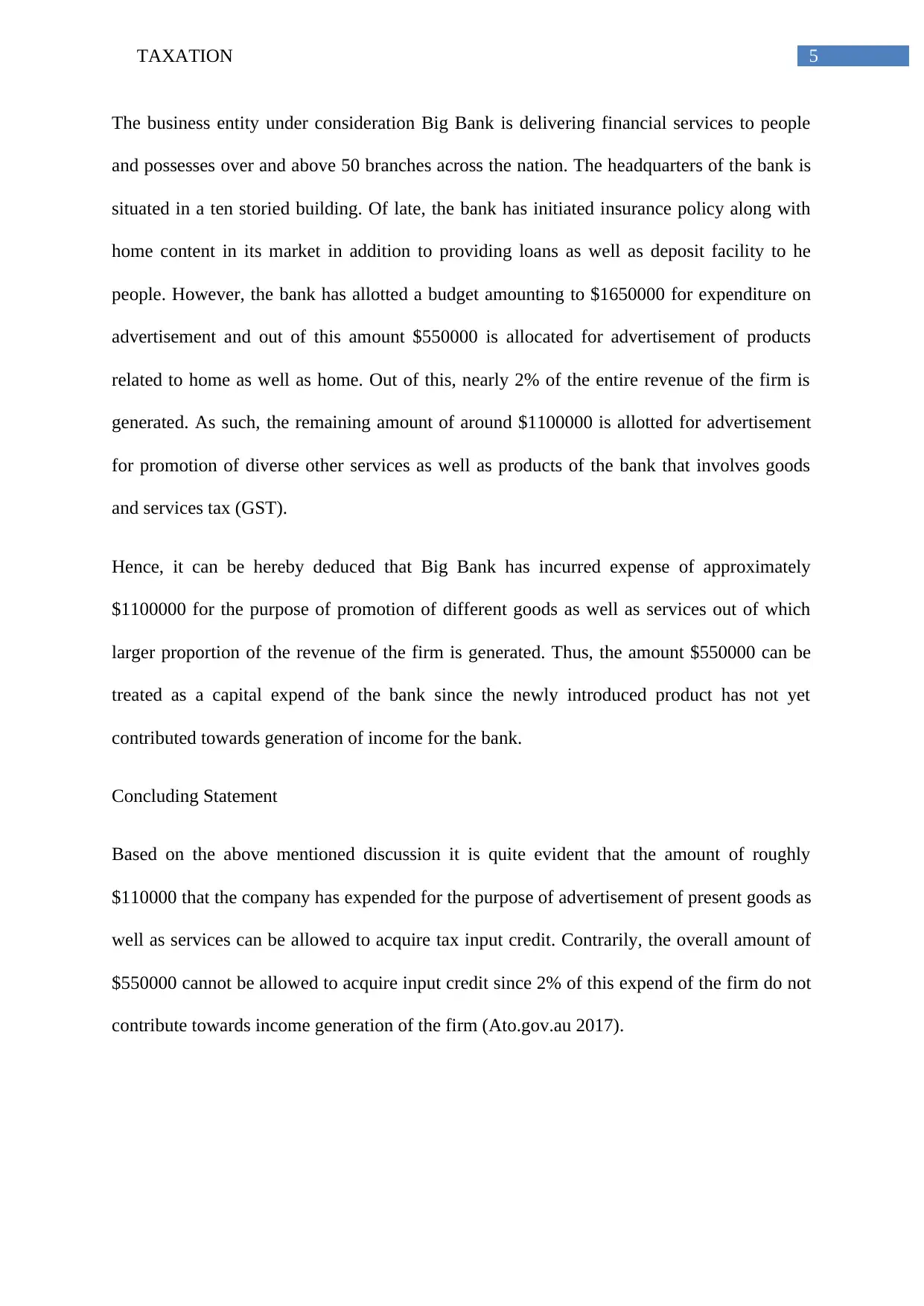
5TAXATION
The business entity under consideration Big Bank is delivering financial services to people
and possesses over and above 50 branches across the nation. The headquarters of the bank is
situated in a ten storied building. Of late, the bank has initiated insurance policy along with
home content in its market in addition to providing loans as well as deposit facility to he
people. However, the bank has allotted a budget amounting to $1650000 for expenditure on
advertisement and out of this amount $550000 is allocated for advertisement of products
related to home as well as home. Out of this, nearly 2% of the entire revenue of the firm is
generated. As such, the remaining amount of around $1100000 is allotted for advertisement
for promotion of diverse other services as well as products of the bank that involves goods
and services tax (GST).
Hence, it can be hereby deduced that Big Bank has incurred expense of approximately
$1100000 for the purpose of promotion of different goods as well as services out of which
larger proportion of the revenue of the firm is generated. Thus, the amount $550000 can be
treated as a capital expend of the bank since the newly introduced product has not yet
contributed towards generation of income for the bank.
Concluding Statement
Based on the above mentioned discussion it is quite evident that the amount of roughly
$110000 that the company has expended for the purpose of advertisement of present goods as
well as services can be allowed to acquire tax input credit. Contrarily, the overall amount of
$550000 cannot be allowed to acquire input credit since 2% of this expend of the firm do not
contribute towards income generation of the firm (Ato.gov.au 2017).
The business entity under consideration Big Bank is delivering financial services to people
and possesses over and above 50 branches across the nation. The headquarters of the bank is
situated in a ten storied building. Of late, the bank has initiated insurance policy along with
home content in its market in addition to providing loans as well as deposit facility to he
people. However, the bank has allotted a budget amounting to $1650000 for expenditure on
advertisement and out of this amount $550000 is allocated for advertisement of products
related to home as well as home. Out of this, nearly 2% of the entire revenue of the firm is
generated. As such, the remaining amount of around $1100000 is allotted for advertisement
for promotion of diverse other services as well as products of the bank that involves goods
and services tax (GST).
Hence, it can be hereby deduced that Big Bank has incurred expense of approximately
$1100000 for the purpose of promotion of different goods as well as services out of which
larger proportion of the revenue of the firm is generated. Thus, the amount $550000 can be
treated as a capital expend of the bank since the newly introduced product has not yet
contributed towards generation of income for the bank.
Concluding Statement
Based on the above mentioned discussion it is quite evident that the amount of roughly
$110000 that the company has expended for the purpose of advertisement of present goods as
well as services can be allowed to acquire tax input credit. Contrarily, the overall amount of
$550000 cannot be allowed to acquire input credit since 2% of this expend of the firm do not
contribute towards income generation of the firm (Ato.gov.au 2017).
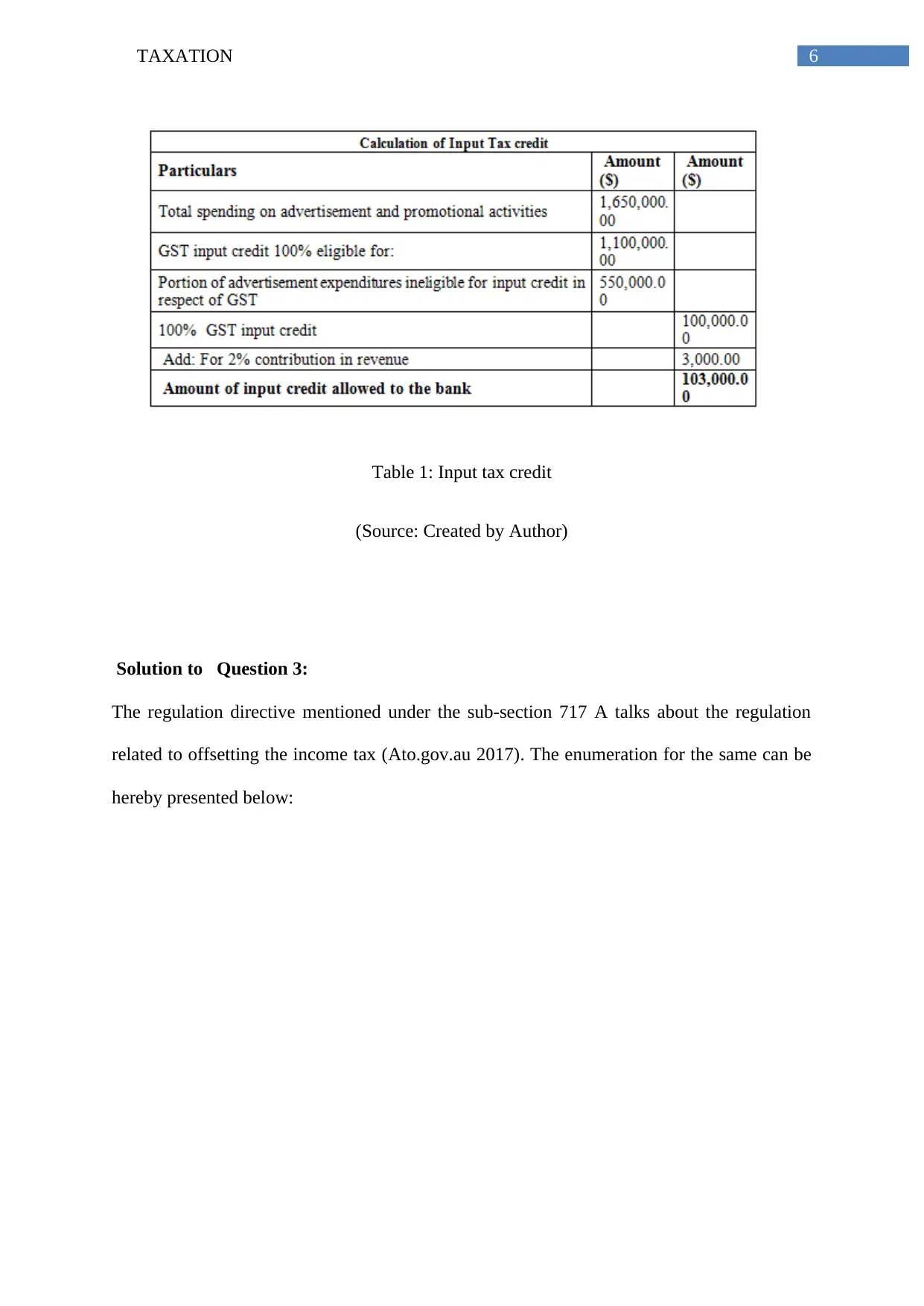
6TAXATION
Table 1: Input tax credit
(Source: Created by Author)
Solution to Question 3:
The regulation directive mentioned under the sub-section 717 A talks about the regulation
related to offsetting the income tax (Ato.gov.au 2017). The enumeration for the same can be
hereby presented below:
Table 1: Input tax credit
(Source: Created by Author)
Solution to Question 3:
The regulation directive mentioned under the sub-section 717 A talks about the regulation
related to offsetting the income tax (Ato.gov.au 2017). The enumeration for the same can be
hereby presented below:
⊘ This is a preview!⊘
Do you want full access?
Subscribe today to unlock all pages.

Trusted by 1+ million students worldwide
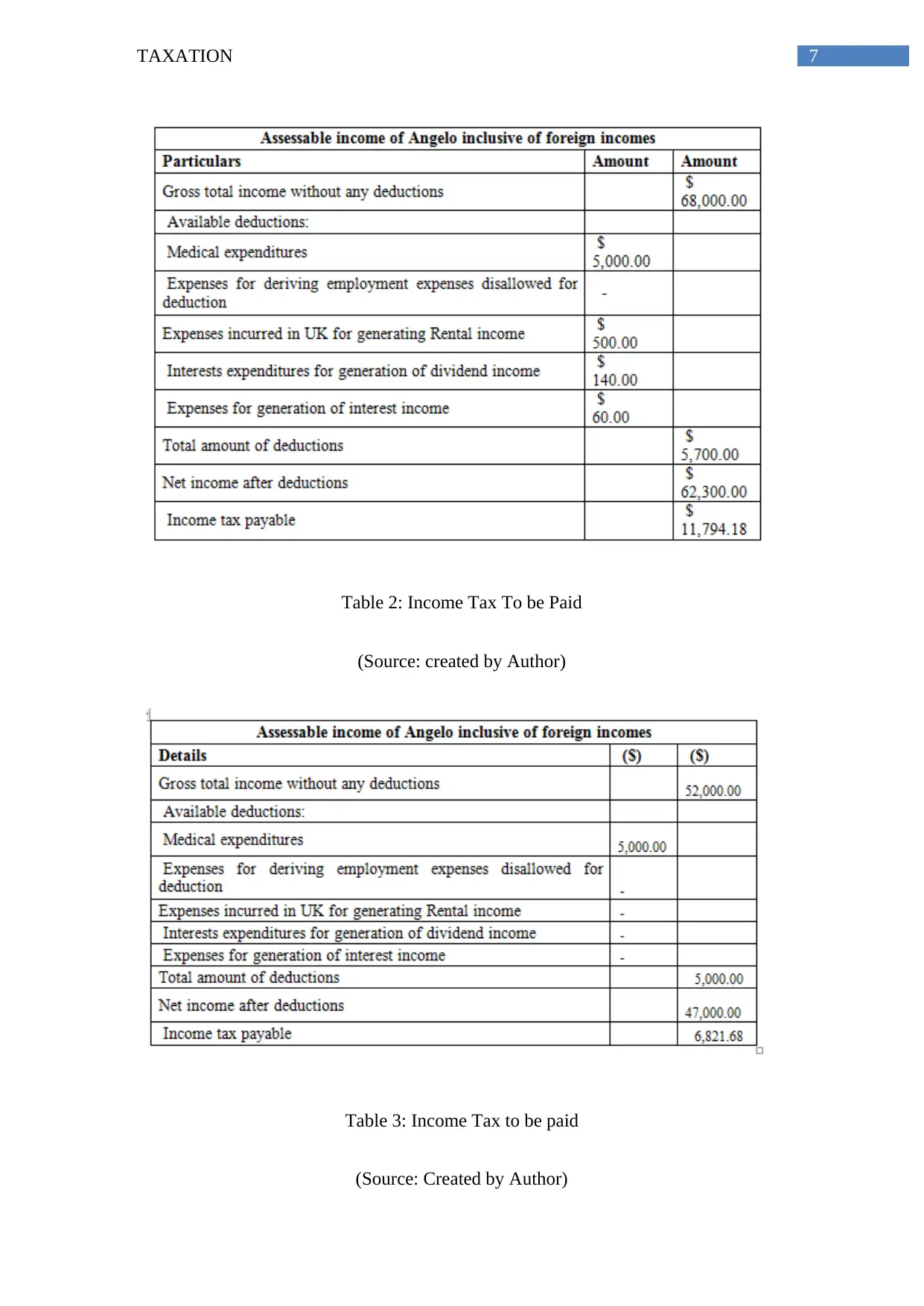
7TAXATION
Table 2: Income Tax To be Paid
(Source: created by Author)
Table 3: Income Tax to be paid
(Source: Created by Author)
Table 2: Income Tax To be Paid
(Source: created by Author)
Table 3: Income Tax to be paid
(Source: Created by Author)
Paraphrase This Document
Need a fresh take? Get an instant paraphrase of this document with our AI Paraphraser
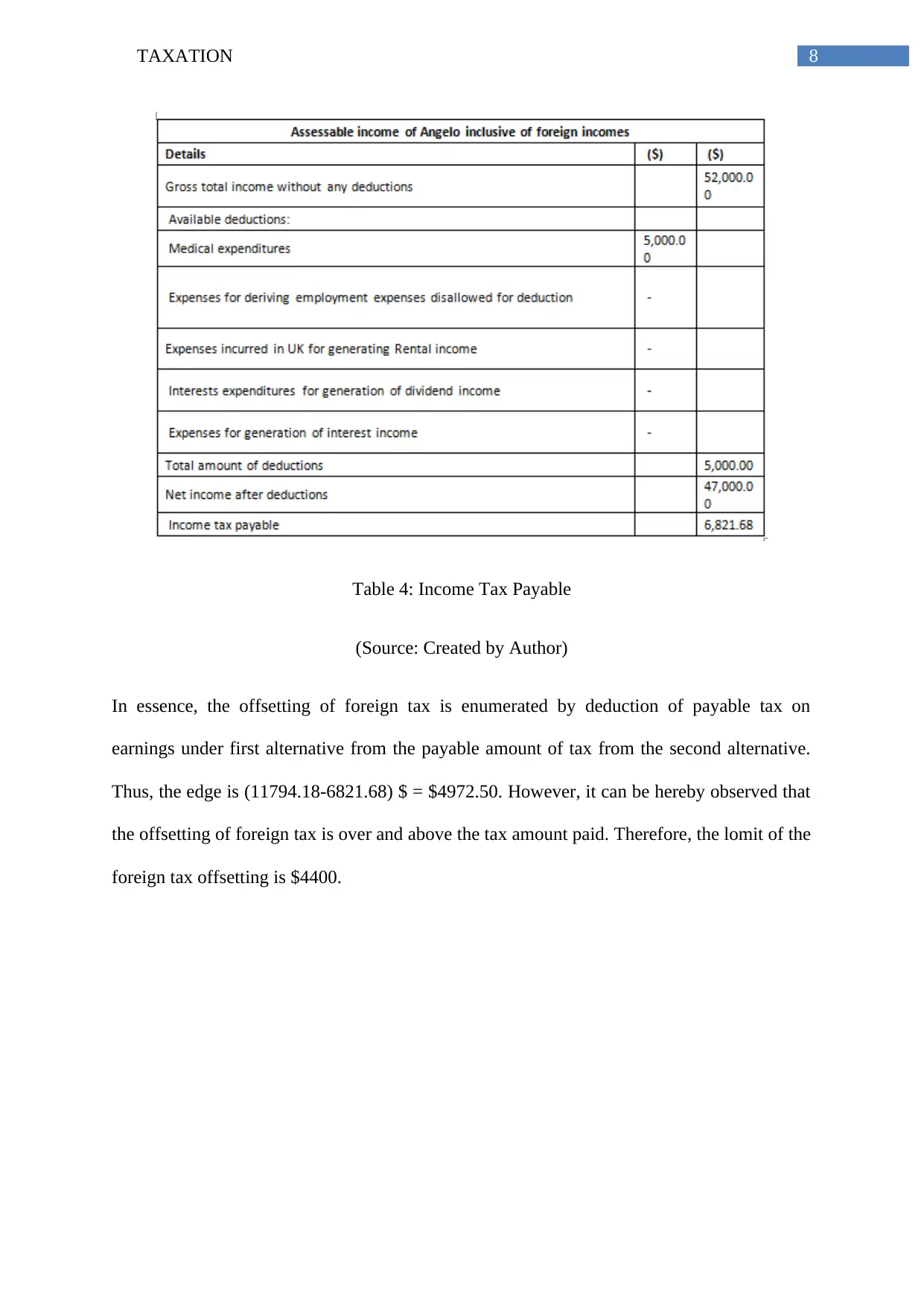
8TAXATION
Table 4: Income Tax Payable
(Source: Created by Author)
In essence, the offsetting of foreign tax is enumerated by deduction of payable tax on
earnings under first alternative from the payable amount of tax from the second alternative.
Thus, the edge is (11794.18-6821.68) $ = $4972.50. However, it can be hereby observed that
the offsetting of foreign tax is over and above the tax amount paid. Therefore, the lomit of the
foreign tax offsetting is $4400.
Table 4: Income Tax Payable
(Source: Created by Author)
In essence, the offsetting of foreign tax is enumerated by deduction of payable tax on
earnings under first alternative from the payable amount of tax from the second alternative.
Thus, the edge is (11794.18-6821.68) $ = $4972.50. However, it can be hereby observed that
the offsetting of foreign tax is over and above the tax amount paid. Therefore, the lomit of the
foreign tax offsetting is $4400.
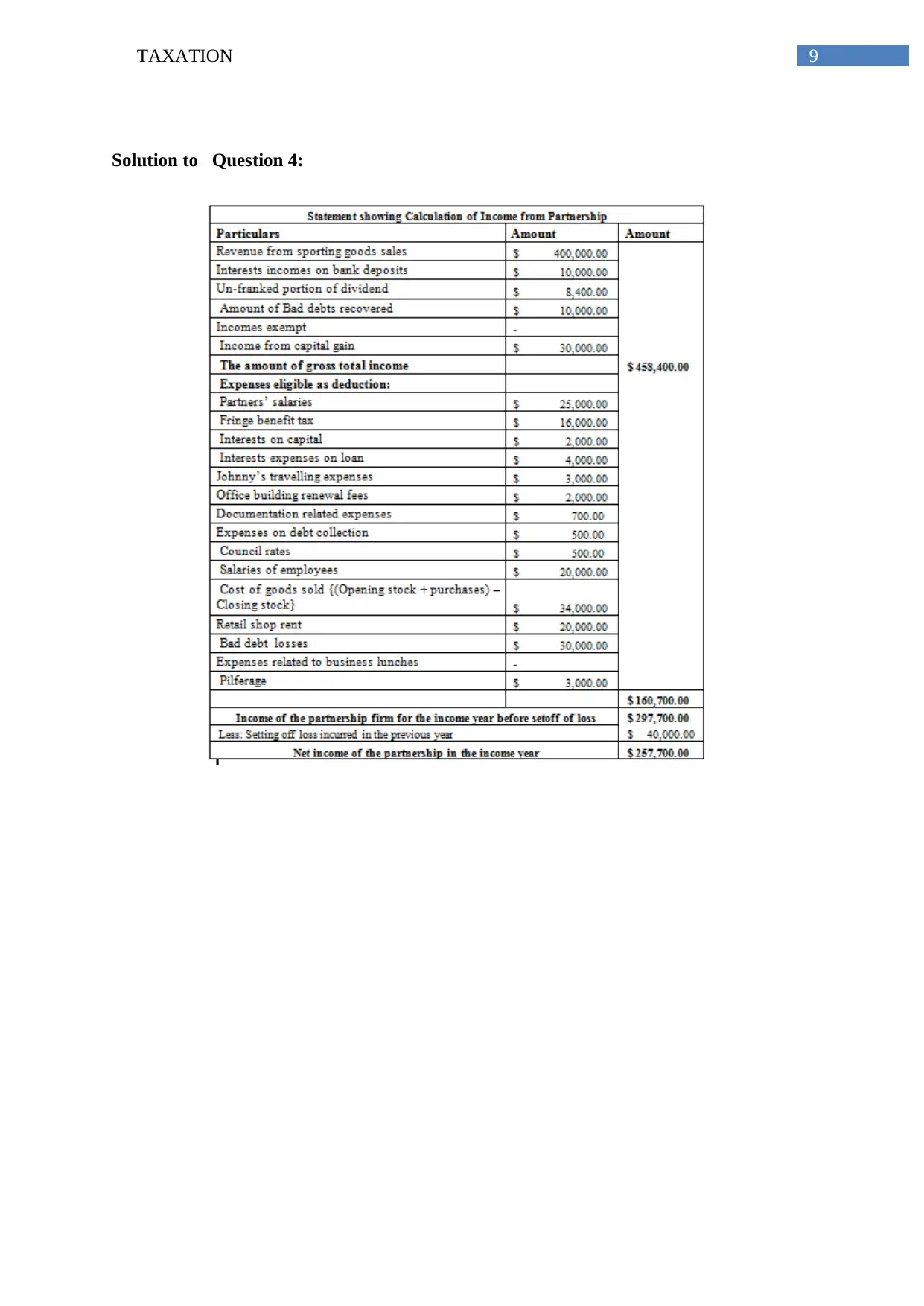
9TAXATION
Solution to Question 4:
Solution to Question 4:
⊘ This is a preview!⊘
Do you want full access?
Subscribe today to unlock all pages.

Trusted by 1+ million students worldwide
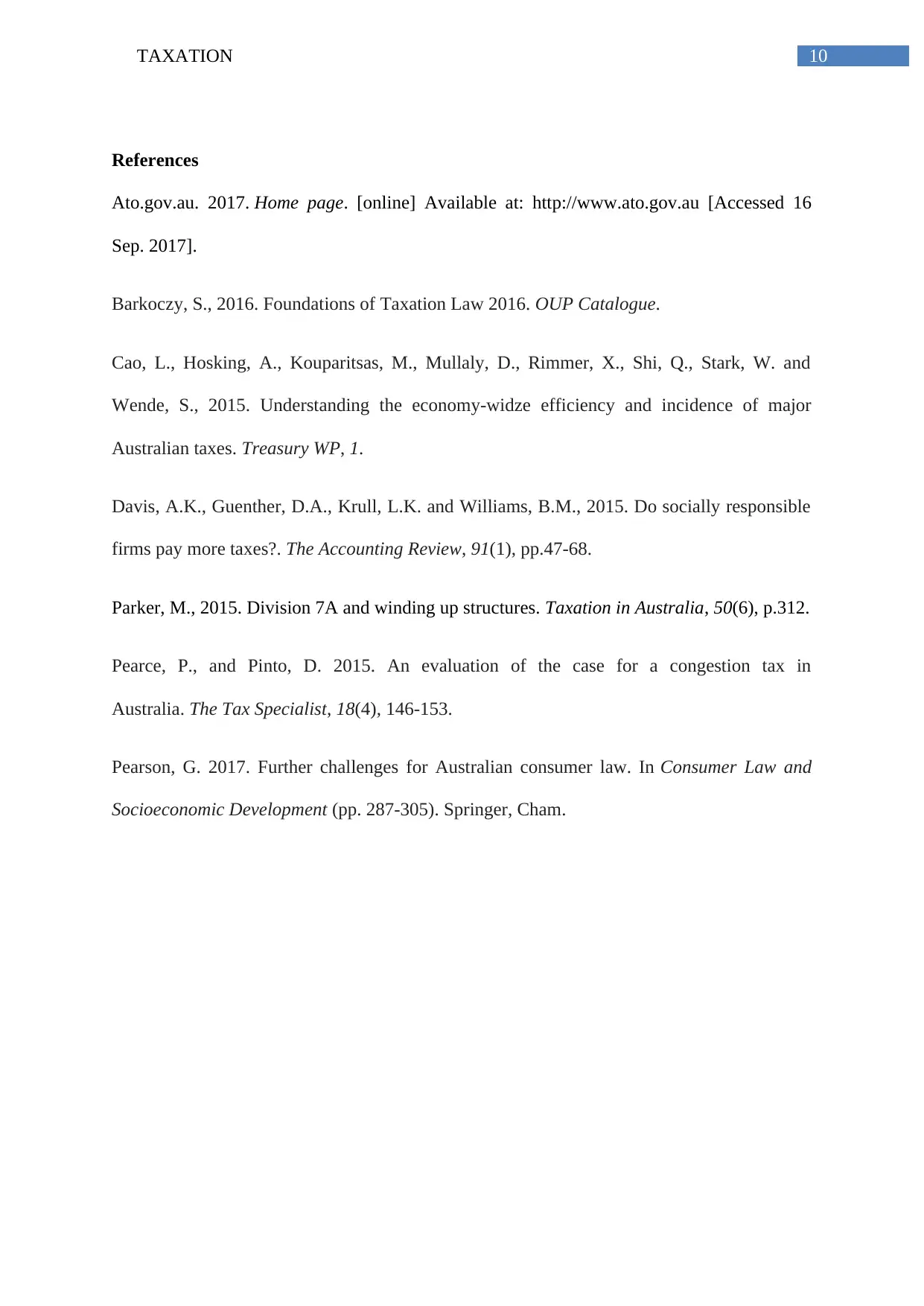
10TAXATION
References
Ato.gov.au. 2017. Home page. [online] Available at: http://www.ato.gov.au [Accessed 16
Sep. 2017].
Barkoczy, S., 2016. Foundations of Taxation Law 2016. OUP Catalogue.
Cao, L., Hosking, A., Kouparitsas, M., Mullaly, D., Rimmer, X., Shi, Q., Stark, W. and
Wende, S., 2015. Understanding the economy-widze efficiency and incidence of major
Australian taxes. Treasury WP, 1.
Davis, A.K., Guenther, D.A., Krull, L.K. and Williams, B.M., 2015. Do socially responsible
firms pay more taxes?. The Accounting Review, 91(1), pp.47-68.
Parker, M., 2015. Division 7A and winding up structures. Taxation in Australia, 50(6), p.312.
Pearce, P., and Pinto, D. 2015. An evaluation of the case for a congestion tax in
Australia. The Tax Specialist, 18(4), 146-153.
Pearson, G. 2017. Further challenges for Australian consumer law. In Consumer Law and
Socioeconomic Development (pp. 287-305). Springer, Cham.
References
Ato.gov.au. 2017. Home page. [online] Available at: http://www.ato.gov.au [Accessed 16
Sep. 2017].
Barkoczy, S., 2016. Foundations of Taxation Law 2016. OUP Catalogue.
Cao, L., Hosking, A., Kouparitsas, M., Mullaly, D., Rimmer, X., Shi, Q., Stark, W. and
Wende, S., 2015. Understanding the economy-widze efficiency and incidence of major
Australian taxes. Treasury WP, 1.
Davis, A.K., Guenther, D.A., Krull, L.K. and Williams, B.M., 2015. Do socially responsible
firms pay more taxes?. The Accounting Review, 91(1), pp.47-68.
Parker, M., 2015. Division 7A and winding up structures. Taxation in Australia, 50(6), p.312.
Pearce, P., and Pinto, D. 2015. An evaluation of the case for a congestion tax in
Australia. The Tax Specialist, 18(4), 146-153.
Pearson, G. 2017. Further challenges for Australian consumer law. In Consumer Law and
Socioeconomic Development (pp. 287-305). Springer, Cham.
1 out of 10
Related Documents
Your All-in-One AI-Powered Toolkit for Academic Success.
+13062052269
info@desklib.com
Available 24*7 on WhatsApp / Email
![[object Object]](/_next/static/media/star-bottom.7253800d.svg)
Unlock your academic potential
Copyright © 2020–2025 A2Z Services. All Rights Reserved. Developed and managed by ZUCOL.




